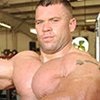I've had the privilege of training many of the world's top strength athletes. Surprisingly, many of them are over 40. Two of my former training partners even achieved world-class feats of strength into their fifties. George Brink became the first person over 50 to deadlift over 800 pounds, and Odd Haugen, at 55, was still winning professional strongman contests.
We've been told that the body begins a gradual decline after about age 30, and for anyone over 40 the best years are behind us—at least physically. But I've seen the opposite first hand. If you're over 40, you can still surprise yourself—and everyone else!
You may not aspire to push your body to the level these elite athletes do, but that doesn't mean it's time to hang up your lifting belt. Here's how to keep those strength gains coming!
1. Value form above all
You may think that I'm about to talk to you about injury risk, and yeah, that's real. But it's not why I'm going to harp on you about form this time.
Here's the thing: Strength is a skill. To develop that skill, you need to do it over and over with perfect form. If strength is the objective and you're over 40, view technical inadequacies as a form of weakness. More now than ever, you must look beyond the equation of brute strength and master the movements you're doing. Repeating bad form engraves the wrong movement pattern, taking you further away from your objectives.
One other thing: When strength is your objective, don't push yourself to or beyond failure, particularly on heavy multi-joint movements. I don't care who you are, at the end of a double dropset, form goes out the window—and that's not helpful for increasing strength.
2. Use Lighter Weights On Single-Joint Exercises
Your elbows, shoulders, and knees are more vulnerable to injury after about age 40 because of the inevitable wear and tear of the cartilage surrounding the joints. Single-joint movements hit them most directly because the load isn't spread across multiple joints. For this reason, I never recommend that over-40 lifters go heavy on isolation moves.

Nestor Rizhniak/Shutterstock
However this doesn't mean avoiding all isolation exercises. The key is to keep isolation movements strict with a moderate weight. Many times I'll even include a 4-5-second eccentric (negative) to help my lifters better develop a mind-muscle connection. Especially after age 40, single-joint movements are not about moving a weight from point A to point B as fast as possible; they're about working a specific muscle most effectively.
Avoid cheat curls, skull-crusher personal records, and swinging lateral raises. Let your strength measuring sticks be big compound movements like squats, presses, and pulls, and only bother doing isolation work that helps you get stronger in these big moves.
3. Embrace the three-phase warm-up
Warming up should never be overlooked by any athlete, but for the over-40 lifter the consequences are even more significant. That's because masters athletes are more likely to have a long rap sheet of injuries. They're also more likely to have at least one serious mobility or flexibility hurdle to deal with, for whatever the reason. Skipping your warm up isn't going to do you any favors here.
Here's my recommendation: Do a 5-10-minute general warm-up on your favorite piece of cardio equipment, with a jump rope, or even just take a brisk walk. Then, perform this dynamic stretching routine, which can be completed in just a couple of minutes.
After that you're ready to start part three of your warm-up: The warm-up sets. If you're squatting and your first working weight calls for 315 pounds, instead of 20 minutes on the elliptical and jumping right to 315, follow a logical warm-up progression something like this:
- Set 1: 6 reps with the Olympic bar (45 pounds)
- Set 2: 6 reps with the Olympic bar
- Set 3: 5 reps with 135 pounds
- Set 4: 5 reps with 135 pounds
- Set 5: 3 reps with 185 pounds
- Set 6: 1 rep with 225 pounds
- Set 7: 1 rep with 265 pounds
- Set 8: 1 rep with 295 pounds
By warming up like this, you get more practice building the skill of the movement, increase training volume, and better mental preparation all without inducing excessive fatigue. Notice that you aren't coming anywhere close to muscle failure. Do clean reps only!
4. Program in more deload work
You are no longer invincible. Well, you never were, but at least you're more aware of it now.
To gain strength, you can't always be going full-tilt in the gym like you could in your twenties. Increasingly you need both down weeks and down workouts. This isn't accomplished by just lying around, however. Rather, you need to plan ahead and include what are known as "deload" sessions.
A good place to start is three weeks of intense training followed by a lighter week with less volume. A good starting point is to use about 70 percent of your previous total training volume on deload weeks, dialing back both the number of sets and reps, and if necessary, the weight you use. Some may need to deload more often, like every third week, whereas others can go longer. Your own frequency of deloads depends on training intensity, volume, recuperative ability, injury history, and host of individual variables.
Don't use deload weeks as blow-off weeks, though. Instead, use them as technical reinforcement weeks. Less total work and lighter weights means this is a prime opportunity to perfect your form.
A Bonus Programming Tip: Just because most of the world operates off a seven-day-a-week cycle doesn't mean your training schedule has to. For example, if you benched and squatted twice a week in your thirties and doing the same thing now leaves you under-recovered, stretch out your week. Your training week can be 9-10 days instead of seven. I use this strategy with my client Tom Deebel, who has officially deadlifted 640 pounds at a body weight of 197. He's 52 years old.
5. Make more time for sleep
The athlete in his or her twenties can lift during the day, party at night, and repeat tomorrow. Not so with most athletes in their 40s. Building strength is always hard, but without adequate recovery, it becomes impossible the older you get. And the best way to recover always has been, and always will be, to sleep more.

Nestor Rizhniak/Shutterstock
Instead of staying up to watch the monologue, the first guest, and the terrible musical performance, do yourself a favor and turn in. You're not missing out on anything.
While you're at it, pay more attention to the quality of your sleep. Having the right mattress is part of this, but so is how you arrange your bedroom and construct your sleep ritual. Sleep in a cool, dark room on a comfortable, supportive mattress. Avoid caffeine, alcohol, and intense exercise late the evening, and turn off anything that can stimulate you—like your TV or phone—well before bedtime. Shoot for a minimum of seven hours of sleep every night. In a perfect world you'd get 8-9.
The more serious you are about your training, the more serious you must be about your rest. It's a wonderful thing, so treat it that way!

